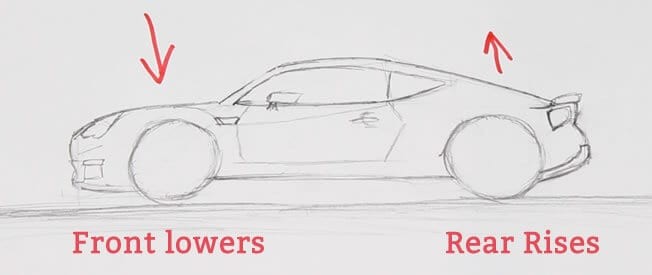Drifting, the art of controlled skidding, is a thrilling motorsport and car control technique. While internet videos often showcase purpose-built drift machines or high-horsepower sports cars effortlessly sliding around corners, many aspiring drivers wonder if it’s possible to drift a regular road car. The answer is yes! This guide will explain how to drift a standard car, even with modest power like a 2-litre, 200 BHP Toyota GT86, focusing on technique and car control.
Where to Learn Drifting: Safety First
Before we dive into the techniques, a crucial word of caution: never practice drifting on public roads. Drifting is inherently risky and requires space and controlled conditions. The ideal environment to learn how to drift safely is on a closed circuit, a designated drift track, or a large, empty tarmac area like an airfield. Many race circuits offer drift days or allow private hire for practice. Setting up cones can help you visualize turns and practice specific maneuvers in a safe and controlled environment, away from traffic and obstacles. Remember, safety is paramount when learning to drift.
The Challenge of Drifting a Road Car
Drifting a road car presents a different challenge compared to purpose-built drift cars. Drift machines are engineered for the task, boasting high horsepower, specialized differentials, and hydraulic handbrakes for easy drift initiation and control. Road cars, in contrast, are typically softer, less powerful, and designed to prioritize grip and stability. They are more prone to understeer, meaning they resist turning and tend to push straight ahead. Therefore, mastering drifting in a road car demands more deliberate and sometimes aggressive inputs with both the throttle and steering – a departure from the smoother, more controlled inputs generally advised for track driving.
To successfully drift a road car, certain prerequisites are essential:
- Rear-Wheel Drive (RWD): Power must be sent to the rear wheels to break traction and initiate a slide. Front-wheel drive cars are not suitable for drifting in the traditional sense.
- Sufficient Power: While you don’t need extreme horsepower, having enough power to overcome rear tire grip is necessary. Cars with very low power may struggle to maintain a drift.
- Manual Transmission (Preferred): While automatic transmissions can be used, a manual gearbox offers greater control over gear selection and engine revs, crucial for drift control.
- Disable Traction and Stability Control: These electronic aids are designed to prevent wheelspin and loss of control, directly opposing the goal of drifting. The ability to completely disable these systems is mandatory.
Step 1: Initiating the Drift – Weight Transfer is Key
Starting a drift in a road car requires more than just applying throttle, especially in cars with moderate power output like the GT86. The key is to utilize weight transfer to reduce grip at the rear tires.
Approach the corner with appropriate speed, then brake firmly. Braking shifts the car’s weight forward, compressing the front suspension and lifting the rear slightly. This reduces the load and consequently the grip on the rear tires.
As illustrated, braking increases the weight and grip on the front tires while decreasing it on the rear. While the car’s weight is shifted forward and the rear is light, initiate the drift by quickly flicking the steering wheel in the direction of the turn. This sudden steering input, combined with the reduced rear grip from weight transfer, should cause the rear tires to lose traction and the car to begin to slide. Immediately apply opposite lock – steering in the opposite direction of the turn – to control the slide and prevent spinning out.
Finding the right balance of braking, steering input, and timing is crucial. Being too gentle with your inputs might result in understeer, where the car pushes straight ahead. Being too aggressive could lead to a rapid spin. Practice is key; focus on feeling how the car responds to your inputs and adjust your technique accordingly with each attempt.
Image: Illustration showing the steering wheel turned in the opposite direction of the intended turn (opposite lock), demonstrating the steering input needed to control a drift.
Step 2: Maintaining the Drift – Throttle and Steering Balance
Once the drift is initiated, the real fun begins – maintaining a controlled slide. This is where the delicate balance between throttle and steering input comes into play. A common mistake for beginners is not using enough throttle. It’s often surprising how much throttle input is needed to keep the rear wheels spinning and the car sideways.
The key to maintaining the drift angle is to use the throttle to control it. Lifting off the throttle will reduce the drift angle, allowing the rear tires to regain some grip and straighten the car slightly. Conversely, applying more throttle will increase the drift angle, pushing the rear of the car further out. Simultaneously, you’ll be making subtle steering adjustments, using opposite lock to keep the car pointed in the desired direction.
Think of it as a constant balancing act between steering and throttle. Keep the engine revs relatively high to ensure sufficient power is available to maintain wheelspin. If you don’t apply enough throttle, the rear tires will regain too much grip, and the car will begin to straighten out. Too much throttle, and you risk increasing the drift angle excessively, potentially leading to a spin if you run out of steering lock.
Step 3: Transitioning the Drift – The Flick and Catch
Transitioning a drift, smoothly switching from drifting in one direction to the other (often in an “S” bend or chicane), is arguably the most challenging part of drifting. It’s a rapid sequence of events that demands precise timing and coordination.
The primary challenge in transitioning is managing the car’s momentum and weight transfer as you change direction. Too aggressive a transition can induce a spin, while a too gentle approach might result in understeer as the car fails to rotate sufficiently in the new direction.
The technique involves slightly over-rotating the car just before you want to change direction. As you approach the transition point, momentarily increase your steering angle and throttle to accentuate the drift in the current direction. Then, quickly lift off the accelerator. This sudden deceleration and weight shift will cause the rear tires to regain grip momentarily and pivot the car in the opposite direction, initiating the drift in the new direction.
As the car transitions, the steering wheel will rapidly unwind and spin in your hands. In many cases, it spins too quickly to maintain a grip. As seen in drifting videos, experienced drivers often let the wheel spin freely through their hands during the transition. The crucial part is to anticipate the wheel’s rotation and catch it at the right point to apply opposite lock for the new direction of drift. This might seem daunting, but with practice, catching the wheel becomes more intuitive.
Immediately after the transition, as the car flicks into the opposite direction, you’ll need to get back on the throttle quickly and decisively to maintain momentum and initiate the drift in the new direction. A successful transition allows you to seamlessly flow from one drift to the next, linking corners together.
Step 4: Exiting the Drift – Smoothly Regaining Control
Eventually, you’ll want to straighten the car and exit the drift. Similar to transitioning, exiting the drift requires a smooth and controlled approach. The car is loaded up with momentum and lateral force during a drift, and abruptly releasing this load can upset the car’s balance.
In a lower-powered car like the GT86, exiting the drift is often achieved by simply allowing the drift to naturally unwind. As you straighten the steering and open up your line through the corner, the car will naturally lose drift angle. The car’s power is insufficient to maintain a large drift angle as the corner opens and steering angle reduces.
The key skill here is timing the release of the steering angle correctly. In more powerful cars, simply straightening the steering might not be enough to exit the drift smoothly. You might also need to slightly reduce throttle input to allow the rear tires to regain grip and pull the car back in line. The amount of throttle reduction depends on the car’s power and the desired smoothness of the exit.
Final Thoughts: Practice and Patience
Learning how to drift a car, especially a road car, takes practice, patience, and a safe environment. Start slowly, focusing on mastering each step individually before linking them together. Remember to prioritize safety and always practice in designated areas away from public roads. With consistent practice and a focus on understanding the car’s dynamics and your inputs, you can learn to drift even in a standard road car and experience the exhilarating thrill of controlled sideways driving.

